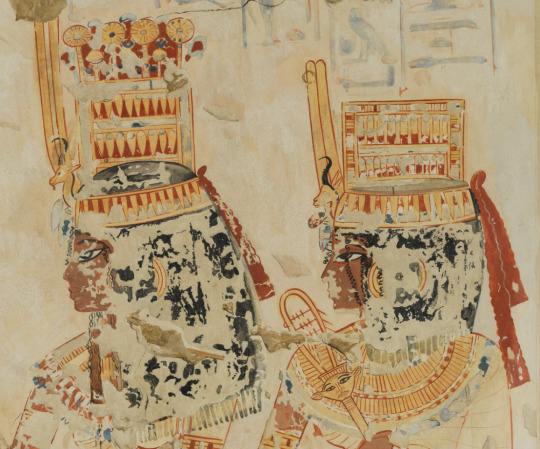#NKPRH
Text







Diadem with a Pair of Gazelle Heads - Met Museum Collection
Inventory Number: 26.8.99
New Kingdom, Dynasty 18, early, ca. 1479–1425 B.C.
Location Information: From Egypt, Upper Egypt, Thebes, Wadi Gabbanat el-Qurud, Wadi D, Tomb of the Three Foreign Wives of Thutmose III
Description:
During her lifetime, a queen wore this delicate diadem tied over her wig. The headband not only identified her elite rank but also identified her as a woman participating in a cultic performance. Tomb depictions illustrate high-ranking women wearing similar ornaments when they took part in rituals that likely honored important goddesses like Hathor, Mut, or Sakhmet. The reason for depicting gazelles is not clear, although they are associated with the sun god, fertility, and rebirth—all subjects connected to these great goddesses. Gazelles inhabit the low desert along the edge of the Nile’s floodplain, often traveling in pairs. This habitat probably explains why these animals figure prominently in a significant myth about the goddesses that takes place in that setting.
#Diadem with a Pair of Gazelle Heads#diadem#diadems#new kingdom#new kingdom pr#dynasty 18#upper egypt#thebes#wadi gabbanat el qurud#wadi gabbanat el-qurud#wadi D#tomb of the three foreign wives of thutmose III#hats#NKPRH#NKPRJ#met museum#26.8.99
1 note
·
View note
Text



Two Daughters of Menna, Tomb of Menna - Met Museum Collection
Note: This is a modern reproduction of an original
Inventory Number: 30.4.194
Original Dating: New Kingdom, Dynasty 18, ca. 1400–1352 B.C.
Location Information: From Egypt, Upper Egypt, Thebes
#Two Daughters of Menna#Tomb of Menna#new kingdom#new kingdom pr#dynasty 18#upper egypt#thebes#met museum#30.4.194#NKPRWHW#NKPRH#womens hair and wigs#hats
0 notes
Text

Ensemble of Rosettes - Met Museum Collection
Inventory Number: 26.8.117a
New Kingdom, Dynasty 18, ca. 1479–1425 B.C.
Location Information: From Egypt, Upper Egypt, Thebes, Wadi Gabbanat el-Qurud, Wadi D, Tomb of the Three Foreign Wives of Thutmose III
Description:
These rosettes from the funerary equipment of three foreign wives of Thutmose III have been diplayed in various ways, since they came to the Metropolitan Museum in 1926. Most familiar to previous viewers is their reconstruction as part of a wig cover with 26.8.117bb as the head piece. Such a cover was first suggested by Herbert E. Winlock in 1937 and later modified. According to present understanding, the joining of the rosettes to the gold disk 26.8.117bb, and the use of strands of rosettes as a wig cover are uncertain.
#Ensemble of Rosettes#met museum#upper egypt#thebes#Wadi Gabbanat el-Qurud#wadi d#Tomb of the Three Foreign Wives of Thutmose III#new kingdom#new kingdom pr#dynasty 18#26.8.117a#womens hair and wigs#hats#jewelry#NKPRWHW#NKPRH#NKPRJ
0 notes